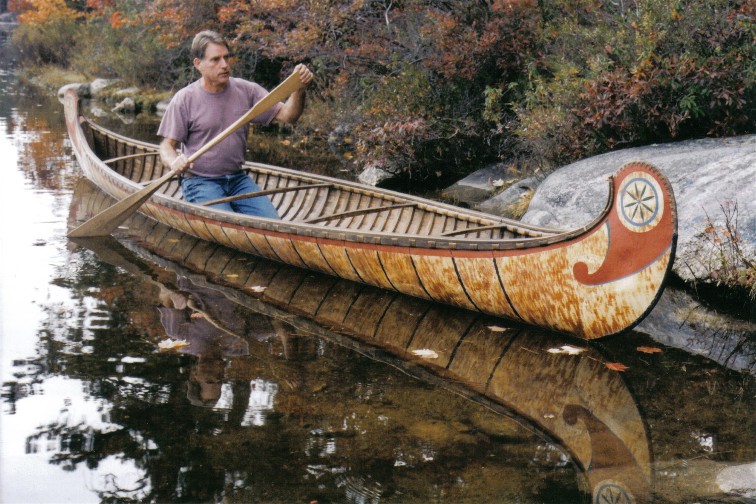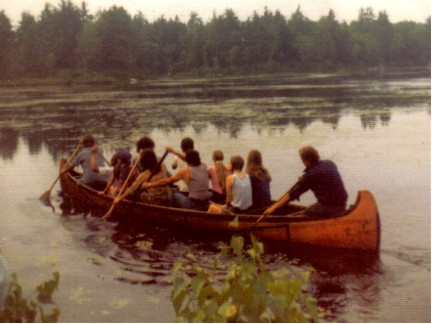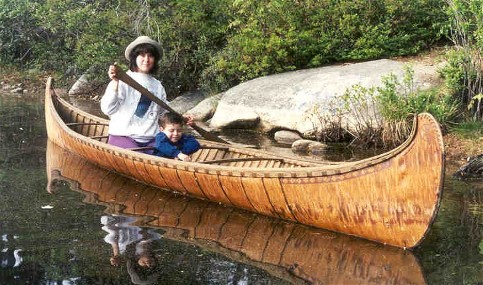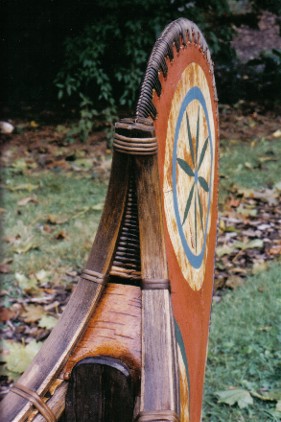| 18 foot Fur - Trade style birchbark canoe | |||||
|
|||||
| 24' Algonquin style Fur-Trade birchbark canoe with 11 passengers | 18' Fur-Trade type birchbark canoe | ||||
|
|
|
|||
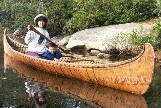 |
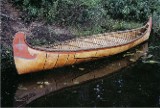 |
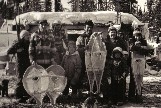 |
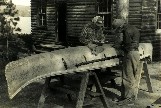 |
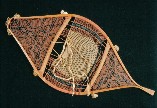 |
| Full size birchbark canoes | Scale model birchbark canoes | Native technology videos and DVDs | Native technology books | |
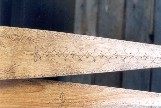 |
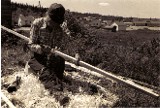 |
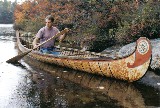 |
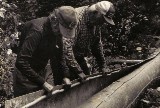 |
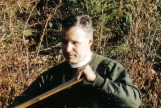 |
| Traditional paddles | Crooked knives | Home |
Materials |
About the builder |
|
A Brief
Historical Background
|
|
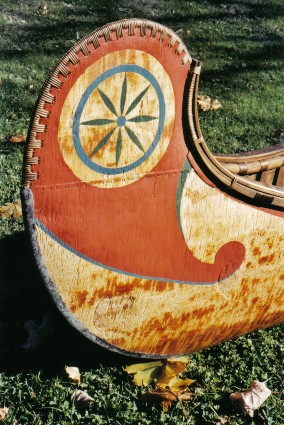 |
When the French sailed into the St. Lawrence Gulf in the 1500's, they were
impressed by the birchbark canoes that were paddled up to their ships.
Lighter and faster than the ship's boats, these bark vessels held heavy
loads , yet were light enough for one man to carry. The Europeans were
quick to realize the superiority of these craft for inland travel in the
New World, and before long , utilized them for exploration and the
beginnings of a trade based on the fur bearers of the country. As this
trade developed , a need for ever larger watercraft sparked a dramatic
increase in the size of these canoes...in some cases up to 40' in length
and 6' in breadth ;capable of carrying up to 5 tons , these canoes could
be carried by four men for miles over the frequent portages of the canoe
routes. Built with materials readily available anywhere in the country,
they could easily be repaired when necessary .
Initially , the Indian builders were the only source of supply for these canoes. However, by the early 1700's a good of number of French families along the St.Lawrence became involved in their production as well. Operating family run '' factories '' for generations , they produced hundreds of canoes for government, military and fur-trade purposes .One such family, headed by Louis LeMaitre of Trois Rivieres, became reknowned throughout the region for their manufacturing of 36' canoes. |
| Decorative sewing around the bow of a fur-trade birchbark canoe | |
|
These enormous canoes have often
been referred to, up to the present day, as " canots du maitre''after
Louis LeMaitre. As the fur trade gradually spread to the country north and
west of the St. Lawrence valley, many of the French builders found employ
in canoe construction at those posts until the end of the nineteenth
century.
In style and construction, these large canoes were basically an enlargement of the tradtional Algonquin type. What evolved over time, however, was an exagerration of the tribal bow profile.The bows became larger and more rounded , giving the canoes a striking appearence. It is unclear whether the French or Native builders, or both, were responsible for this change in the appearence of these large canoes . What is known is that this type became synonymous with ''the Indian birchbark canoe'' in the public's mind , and was the model used for exploration , travel , and fur trading purposes throughout Canada for more than 200 years. |
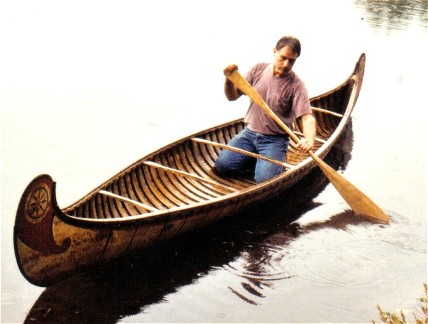 |
|
18' fur-trade birchbark canoe |
|
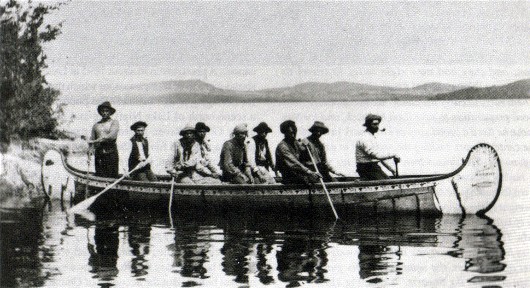 |
It was not until the advent of the railroad , and then the development of the wood-canvas canoe , that the era of the great fur-trade birchbark canoes came to an end in the early twentieth century. However , canoe trasportation remained important over a large part of Canada well into the mid twentieth century for many of it's inhabitants, as well as the Hudson's Bay Co, which continued to supply their northern posts over the old trade routes. |
| Elaborately decorated fur-trade birchbark canoe on Lake Chibougamau, Quebec , 1892 ; note the name ROBROY on the bow ; photo courtesy of Canadian Museum of Civilization |
| Available sizes
and details
|
|
|
These fur-trade birchbark canoes
can be made in lengths from 16' to 40' with beams ranging from 3' to 6' .
The 18' and 20' sizes represent the smaller of the canoes used during the
Fur-Trade era ; due to their limited cargo carrying capacity , they were
not as common as the larger 24' to 36' canoes . However in later years,as
the fur-trade introduced new ideas throughout Canada , these smaller craft
were frequently adopted by Native people for their own use in preference
to their own tribal styles.
The decoration of these fur -trade canoes was varied , and often elaborate. Names , crests , and other insignia were often painted on the bows after the fashion of European boats . The initials HBC were commonly seen on the canoes of the Hudson's Bay Company, |
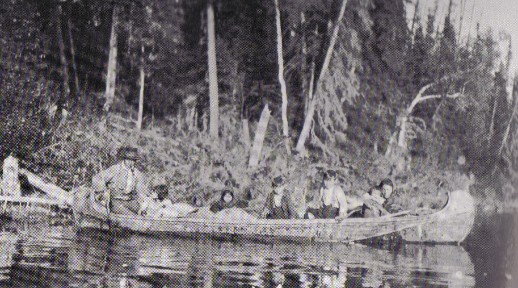 |
|
Cree Indian family in small fur-trade type birchbark canoe, Abitibi River, 1907 |
|
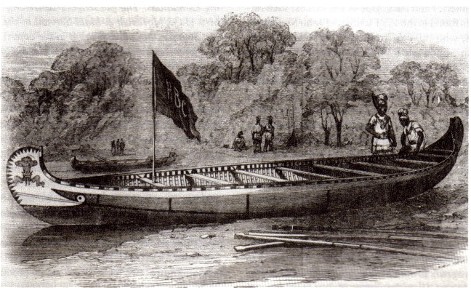 |
The gunnels and thwarts were frequently painted in contasting colors, and the bows in a solid color , usually white , although other colors were sometimes used. Against this background other decorations were applied , with the various circular rayed forms being especially popular. The bark below the gunnels was commonly painted in a band several inches wide ; against this background, elaborate designs were sometimes painted on the more highly finished canoes . |
| Illustration from the ''Illustrated London News'' , Feb.9,1861 of the birchbark canoe presented to the Prince of Wales during his visit to Canada in 1860 . Measuring 40' in length, 6' in breadth, and 27'' deep, it is the longest fur-trade type canoe on record. |
| A common and very elegant form of ornamentation was the decorative root stitching around the large curved bows of the fur-trade canoes . In no other native canoe type is this form of decoration used to greater effect . Harmonizing beautifully with the root lashing of the gunnels and the sewing of the bark cover , the repeated pattern of stitches in triangular or block form around the bows lent an unsurpassed grace to these striking canoes. |
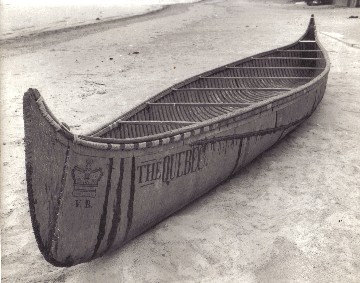 |
|
25' birchbark fur-trade canoe ''THE QUEBEC'' built for the regatta in honor of the Prince of Wales in 1860; it features the tribal Algonquin bow profile rather than the usual fur-trade end ; photo Rick Nash , 1972 |
![Bow view of 25' fur-trade type birchbark canoe , ''THE QUEBEC'', under repair by Henri Vaillancourt and Rick Nash in 1972. It features the royal crown painted on the ends with the initials V.R. [ Victoria Regina ] underneath.](images/algonquin4quebecbow-sm.jpg) |
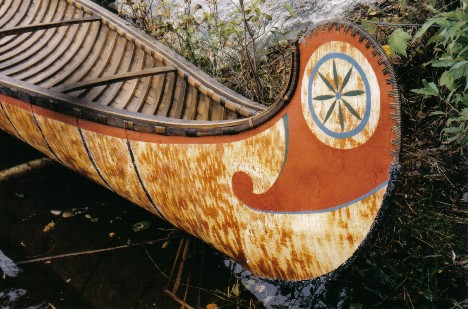 |
| Bow view of 25' fur-trade type birchbark canoe , ''THE QUEBEC'', under repair by Henri Vaillancourt and Rick Nash in 1972. It features the royal crown painted on the ends with the initials V.R. [ Victoria Regina ] underneath. | Decorative root sewing on bow of 18' fur-trade type birchbark canoe with typical painted ends ; made by Henri Vaillancourt 2004 |
|
|
|
|
The joining of the gunnel ends of a fur-trade type birchbark canoe with decorative root lashings ; made by Henri Vaillancourt 2004 |
|
[TOP]
For more information not included on this website
email
henri5@birchbarkcanoe.net
phone 603-878-3616
or write Henri Vaillancourt
PO Box 142
Greenville, New Hampshire, 03048
